How to Change the Timing Belt & Water Pump
1990-1994 Lexus LS400
This is not easy and so it should not be attempted unless you have VERY strong mechanical skills. On a scale of 1-10 I would say this is a 9/10; 10/10 would be a complete engine rebuild. It's quite hard but it can easily save you hundreds dollars. The dealer changes around $1000-$1500 for this. The reason this is such a costly maintenance item is that you have to disassemble nearly half the engine...very time consuming. In reality this really isn't just one procedure, it's a combination of many.
I would recommend having plenty of time and plenty of space if you're going to do this. It takes certified mechanics 10-15 hours to do this so plan on the entire weekend. When removing the parts place them on the ground in the order they were removed. Then when you put everything back together you can easily work backwards.
Most dealers recommend changing the timing belt every 90,000 miles. Depending on driving habits and conditions the belt may last longer. I have heard of belts lasting 180,000 miles! The first gen LS's (1990-1994) have a non-interface engine, so if the timing belt breaks it's not going to damage the engine. If it breaks you'll just be stranded. Some belts break and some last.
Tools Needed:
- Breaker bar or impact wrench
- Socket wrenches
- Socket extensions
- Angled socket joints
- Torque wrench capable of reading at least 181 ft-lb
- Sockets 8-22mm + 8mm hex socket
- Harmonic balancer pulley remover (this can usually be rented from Autozone or buy one)
Parts Needed:
- Timing belt ~$52
- Water pump ~$155
- No.1 idler pulley ~$98
- No.2 idler pulley ~$62
- Timing belt tensioner ~$40
Optional Parts to Replace:
- Spark plugs
- Spark plug wires
- Thermostat
- Distributors
- Rotors
- Drive belt
- Air filter
1) Drain engine coolant. Follow steps 1-8.
2) Disconnect battery, remove air intake and engine covers. Follow steps 3-15.
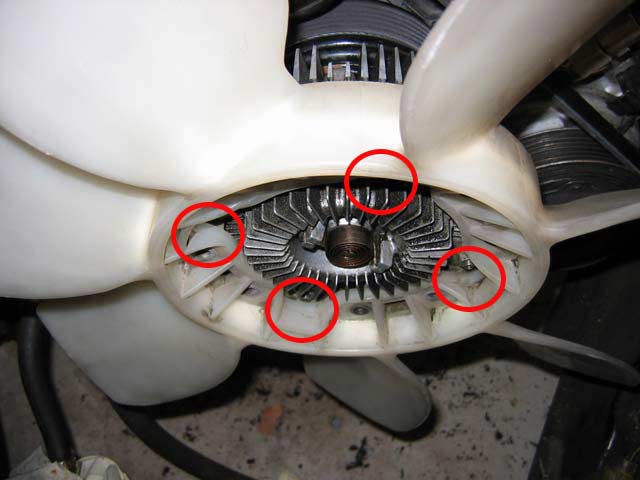
3) Remove the 4 nuts to remove the fan.
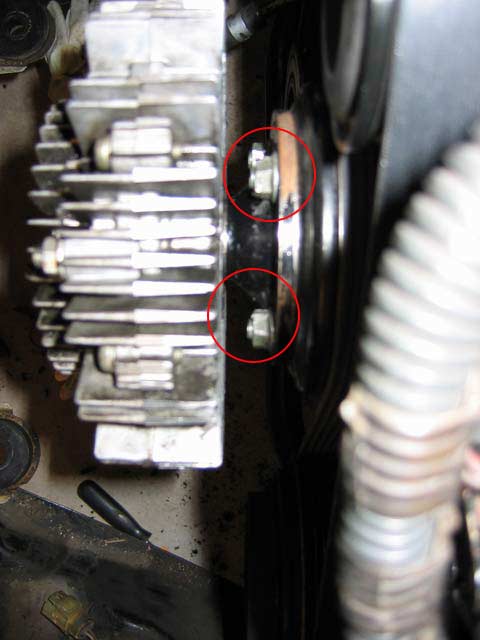
4) Remove the 4 nuts to remove the fan clutch. Use two wrenches to make removal easier. Put one wrench on a nut to use it for leverage. Use the other wrench on another nut to remove it. Mess around with it and you'll figure it out.
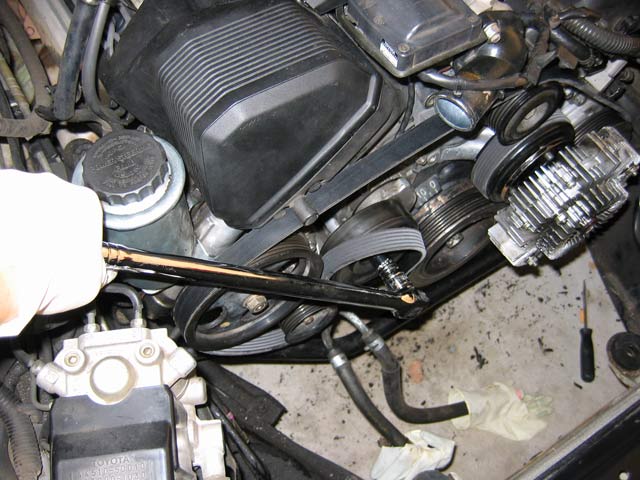
5) Using a 14mm socket, turn the belt tensioner counter-clockwise with one hand and slip the drive belt off with your other hand.
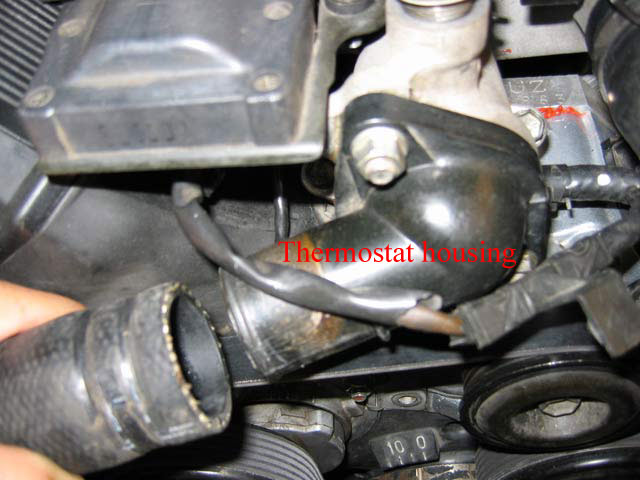
6) Loosen the clamp and then disconnect the coolant hose from the thermostat housing.
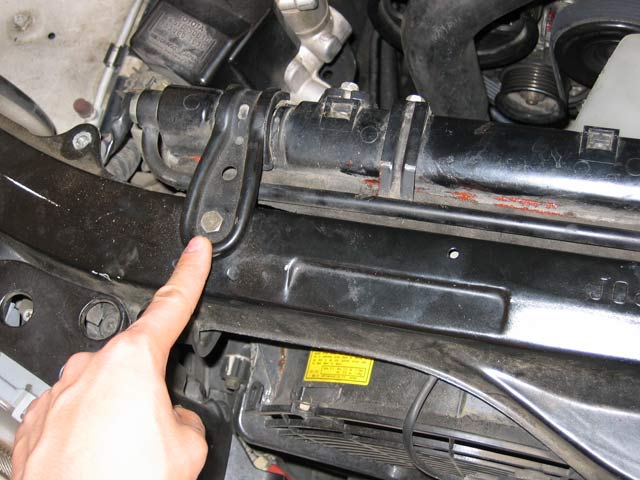
7) Remove the radiator. Disconnect the cooling fan motor connector. Then remove this bolt and the one on the other side, disconnect the 2 ATF hoses at the bottom of the radiator, the other radiator hose, and then remove the radiator. Be prepared for some ATF to drain out of the hoses and radiator.
8) Remove the spark plug wires on the distributor caps. If you're going to be replacing your spark plug wires and spark plugs remove all the wires at this point.
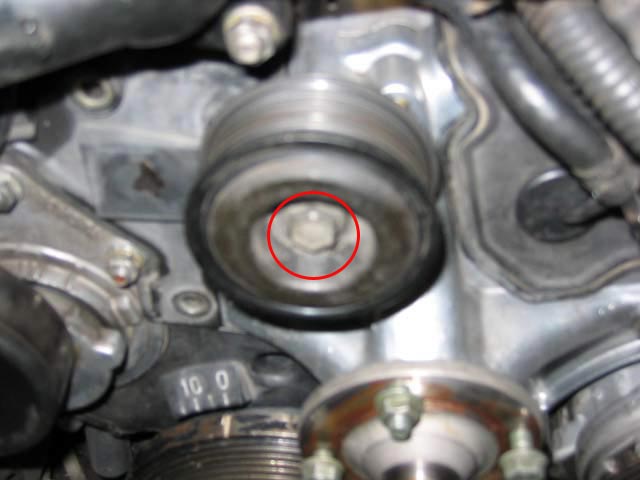
9) Remove the drive belt idler pulley.
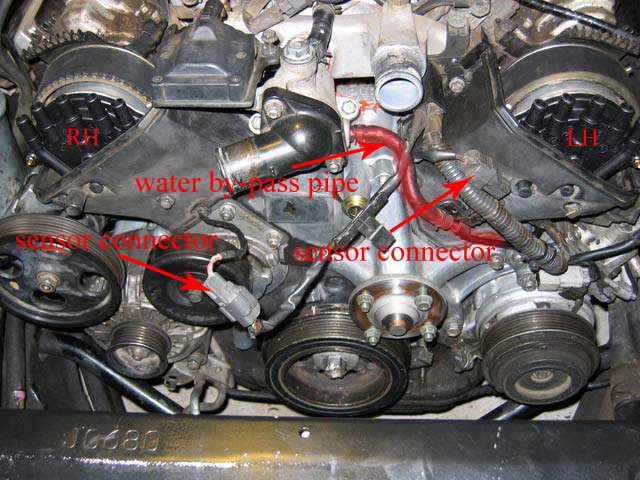
10) Disconnect the sensors from the two timing belt covers (the plastic pieces covering half of the distributor caps). Remove the 5 10mm and 12mm bolts to remove the RH timing belt cover. You'll need some extensions to get the bolt by the power steering pump. Disconnect the LH ignition coil connector. Then remove the 2 bolts and remove the LH ignition coil. Disconnect the water by-pass pipe and remove it. Finally, remove the bolts on the LH timing belt cover and remove it.

11) Remove the three 8mm bolts and remove the distributor caps.
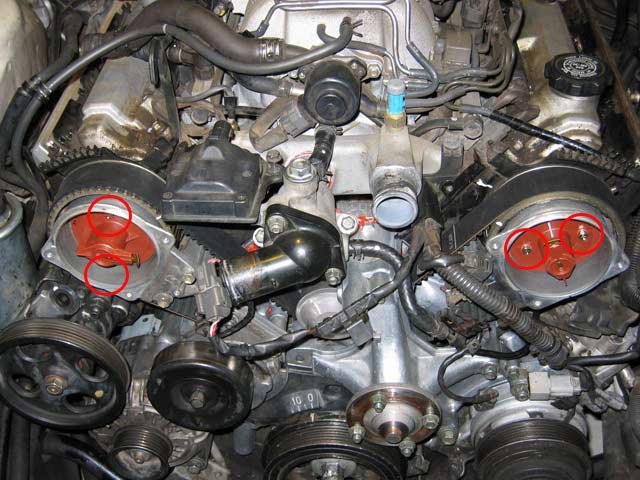
12) Remove the two 8mm bolts and remove the distributor rotors.

13) Disconnect the crank position sensors from each distributor housing (the metal housing that the distributors bolt to). Then remove the 3 12mm bolts (locations highlighted) to remove each distributor housing.
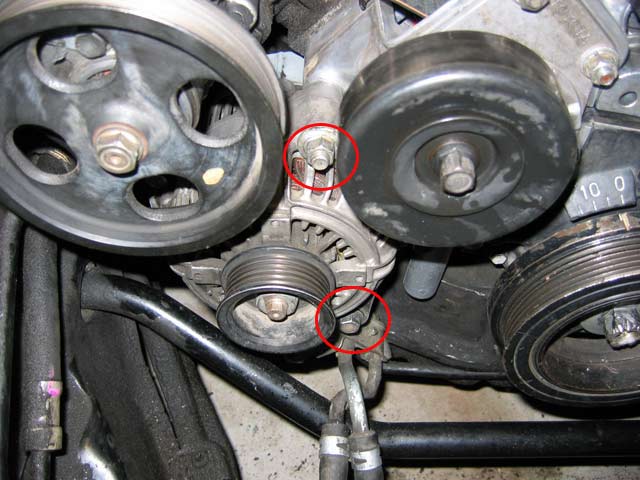
14) Disconnect the alternator connector and wire. Then remove the 14mm nuts, engine wire bracket, and alternator.
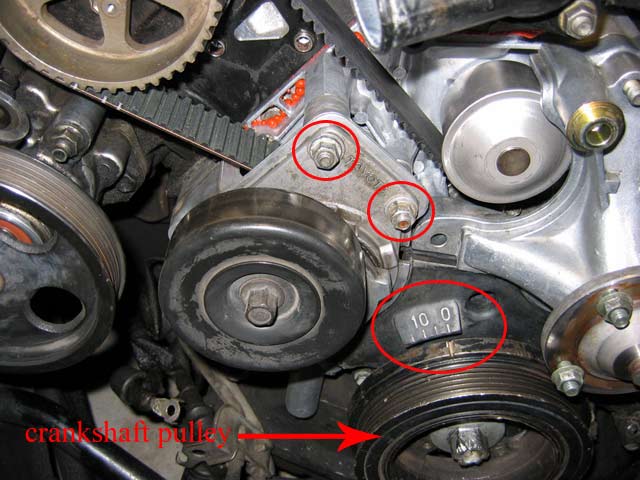
15) Remove the 2 12mm nuts and the drive belt tensioner. Set the crankshaft pulley mark to the 0 as shown in this pic; make sure the marks on your camshaft pulleys line up as well.

16) Remove the two 12mm bolts and timing belt tensioner.

17) Using a 14mm socket, slightly turn the RH camshaft pulley bolt clockwise to loosen the tension on the timing belt. Then remove the timing belt from the camshaft pulleys.
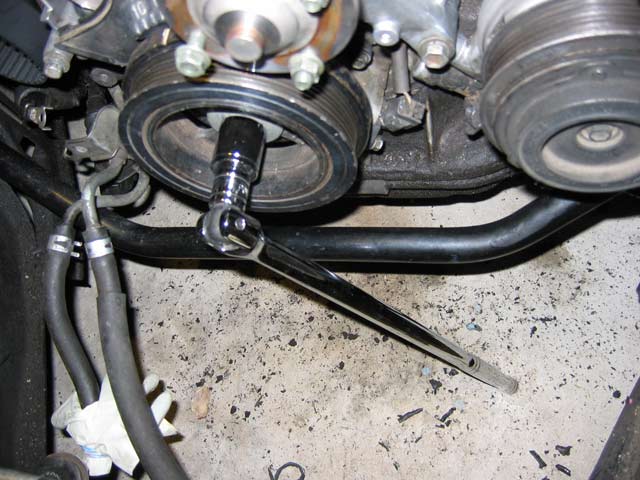
18) Remove the 22mm crankshaft pulley bolt. You will need a breaker bar or impact wrench because it's torqued on at 181 ft-lb.
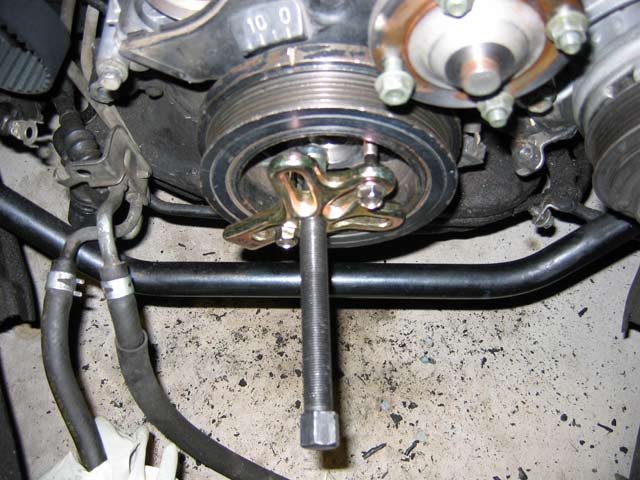
19) Use the harmonic balancer pulley remover to remove the crankshaft pulley
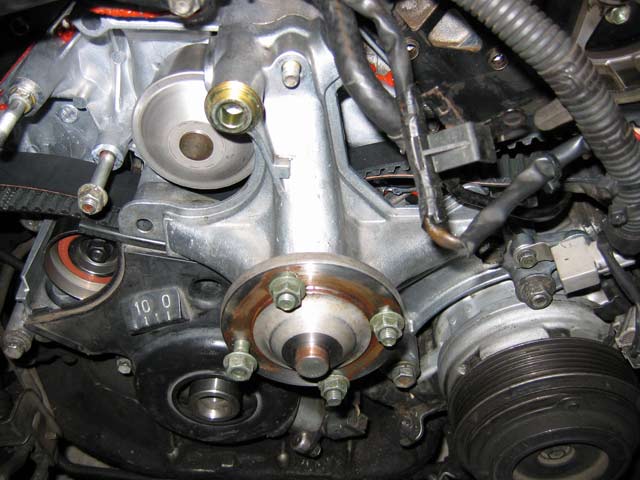
20) Remove 4 bolts, 2 nuts, and fan bracket.
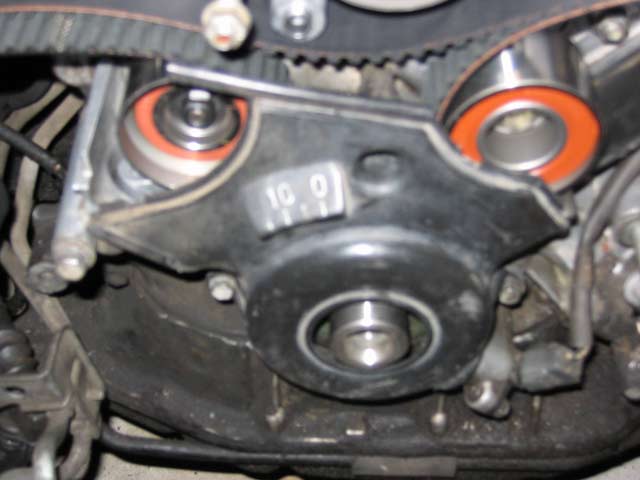
21) Remove the 4 10mm bolts, timing belt cover, and gasket.
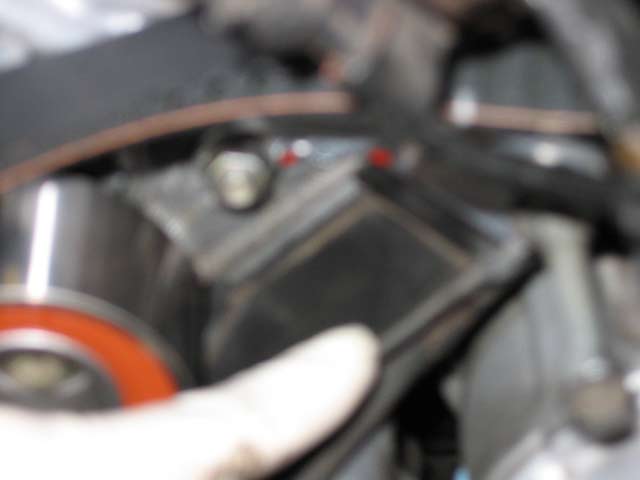
22) Remove the timing belt cover spacer and gasket.
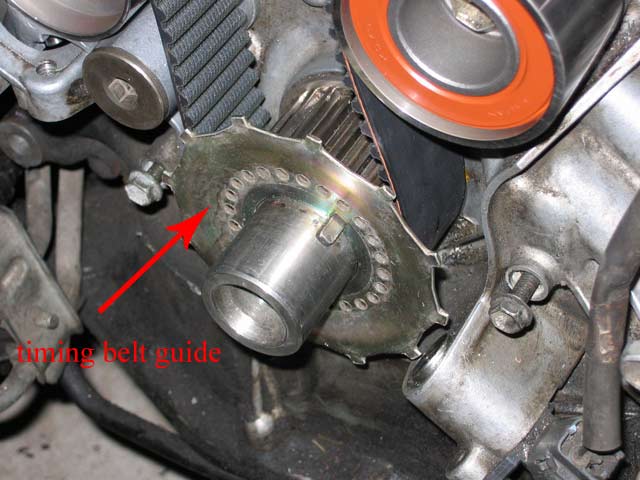
23) Remove the timing belt guide then remove the timing belt.
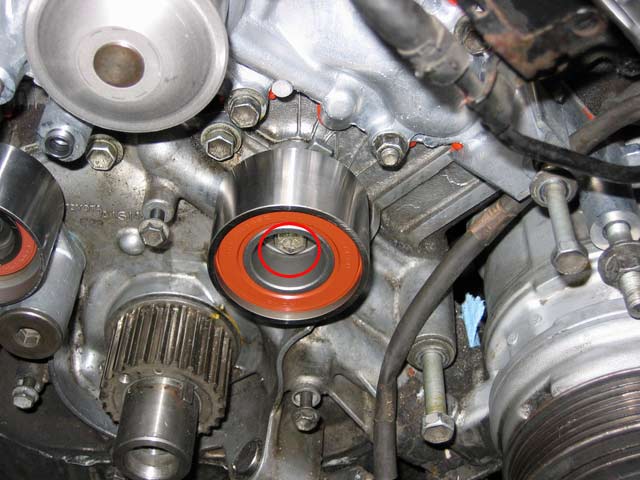
24) Remove the 14mm bolt and No.2 idler pulley.

25) Using a 8mm hex socket, remove the bolt and No.1 idler pulley.
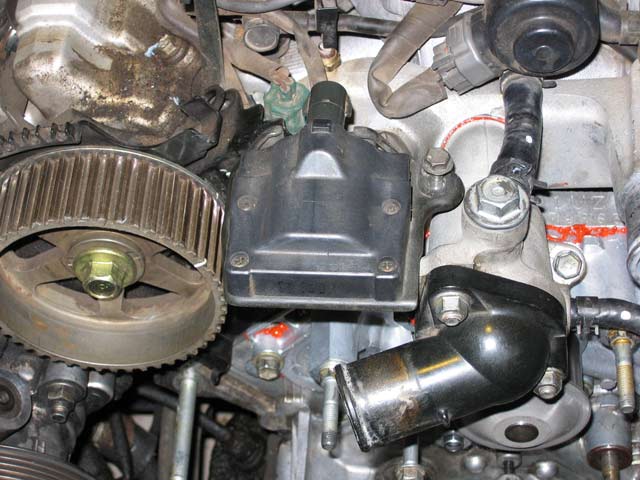
26) Remove the three bolts and the RH ignition coil.
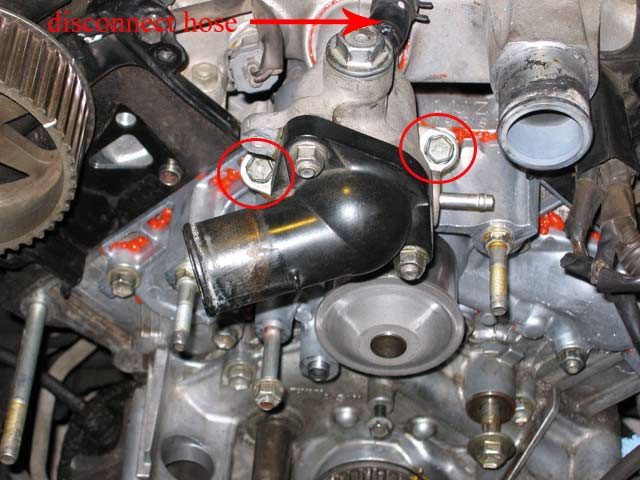
27) Remove the two bolts, disconnect the water hose, and remove the water inlet housing. You may need to give the water inlet housing a few gentle taps with a soft-headed hammer to loosen it.

28) Remove the 5 12mm bolts (circled in red), one 12mm nut (green highlight), and 2 bolt studs (red highlights). Use a strong screwdriver or pry bar between the water pump and cylinder block to pry it off, be careful not to damage the block. Clean all the old sealant, grease, coolant, and dirt off the cylinder block.
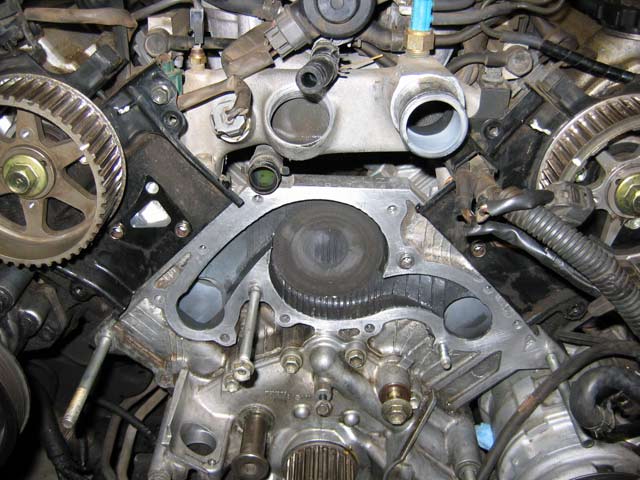
Here's what it will look like with the water pump removed and everything cleaned up.
*** Removal is now complete ***
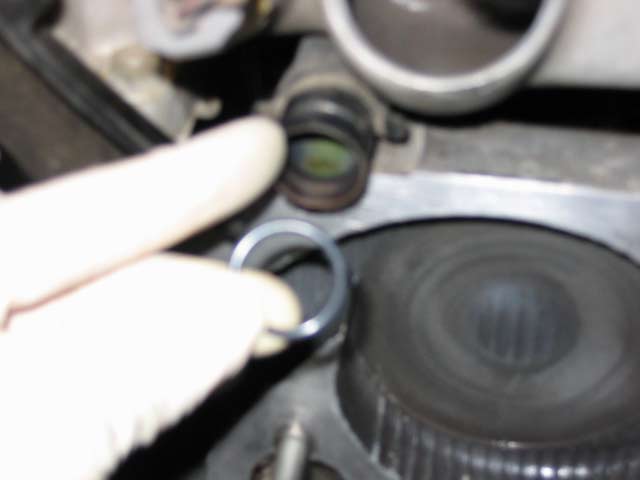
29) Replace the O-ring on the water by-pass pipe. Apply a little soapy water to the O-ring. The O-ring comes with the water pump.
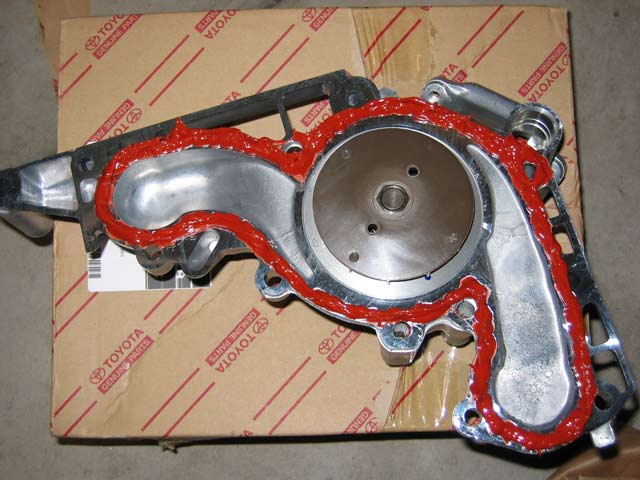
30) Apply high temperature sealant to the groove on the new water pump. Within 5 minutes of applying the sealant, install the water pump on the cylinder block using equal pressure. Gradually torque the 5 bolts, nut, and two bolt studs to 13 ft-lb (185 kg-cm, 18 Nm).
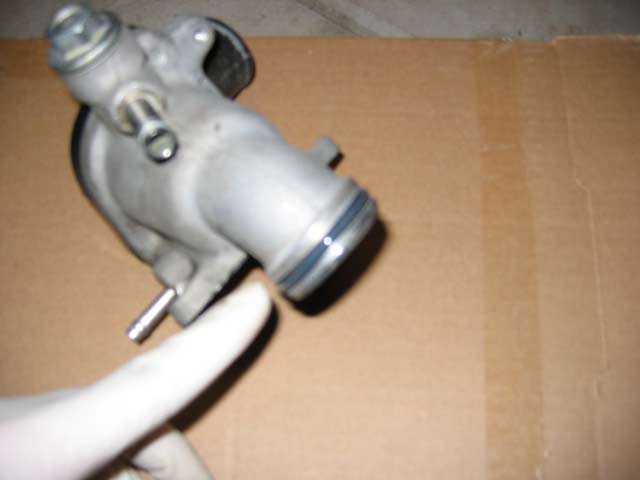
31) Replace this O-ring on the water inlet housing. Apply a little soapy water to the O-ring. Apply high temperature sealant to the groove on the water inlet housing. Within 5 minutes of applying the sealant, install the water inlet housing. Torque the 2 bolts to 13 ft-lb (185 kg-cm, 18 Nm). Connect the water hoses to the water inlet housing.
32) Install the No. 1 idler pulley. Using a 10mm hex socket, torque the bolt to 25 ft-lb (350 kg-cm, 34 Nm). Check to make sure it moves smoothly. See step 25 to see how it should look, then press backspace to return here.
33) Install the No. 2 idler pulley. Torque the 14mm bolt to 25 ft-lb (350 kg-cm, 34 Nm). Check to make sure it moves smoothly. See step 24 to see how it should look, then press backspace to return here.
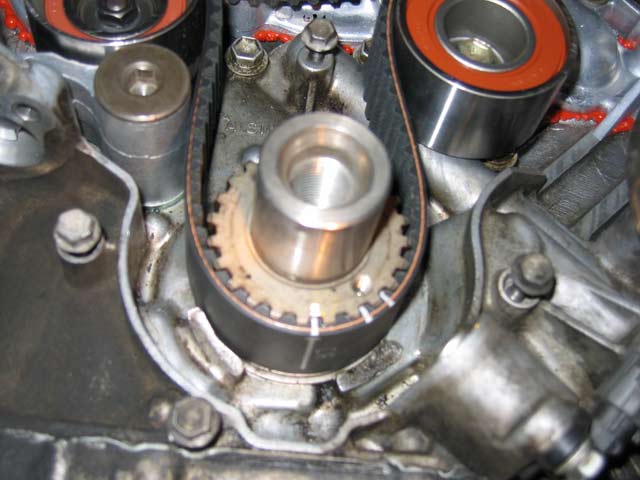
34) Install the timing belt. Align the installation mark on the timing belt (white arrow marked "CR") and crankshaft line up as shown in pic. Run the belt over the No. 1 and No. 2 idler pulleys and under the water pump pulley.
35) Install the timing belt guide; see step 23 to see how it should look, then press backspace to return here.
36) Install the timing belt cover spacer; see step 22 to see how it should look, then press backspace to return here.
36) Install the timing belt cover with the 4 bolts; see step 21 to see how it should look, then press backspace to return here.
37) Install the fan bracket, torque the 12mm bolts to 12 ft-lb (160 kg-cm, 16 Nm), torque the other bolts to 22 ft-lb (310 kg-cm, 30 Nm); see step 20 to see how it should look, then press backspace to return here.
38) Install the crankshaft pulley, torque the pulley bolt to 181 ft-lb (2500 kg-cm, 245 Nm); see step 18 to see how it should look, then press backspace to return here.
39) Check to make sure both camshaft pulley bolts are torqued to 80 ft-lb (1100 kg-cm, 108 Nm).
40) Turn the crankshaft pulley so it is aligned with the "0" mark on the timing belt cover; see step 15 to see how it should look, then press backspace to return here.
41) Check to make sure the timing marks on both camshaft timing pulleys line up with the marks on the engine (white marks), then pull on the belt and install it onto the LH camshaft timing pulley. The "L-CAM" line on the timing belt should run right in between the marks. Do the same for the RH side of the belt. See step 17 to see how it should look, then press backspace to return here.
42) Install the timing belt tensionser. Alternately tighten the two 12mm bolts to 20 ft-lb (270 kg-cm, 26 Nm); see step 16 to see how it should look, then press backspace to return here.
43) Important: Check the valve timing. Turn the crankshaft pulley clockwise two full revolutions using a 22mm socket, from TDC to TDC. See step 15 to see how it should align, then press backspace to return here. The mark on each camshaft timing pulley should align with the mark on the engine. If the marks do not align you messed something up, remove the timing belt and reinstall it.
44) Install the drive belt tensionser, torque the two 12mm bolts to 12 ft-lb (180 kg-cm, 18 Nm); see step 15 to see how it should look, then press backspace to return here.
45) Install the alternator, torque the 14mm bolts to 26 ft-lb (360 kg-cm, 35 Nm) and torque the nut to 27 ft-lb (380 kg-cm, 37 Nm). Connect the alternator connector and wire; see step 14 to see how it should look, then press backspace to return here.
46) Install the RH and LH distributor housings. Each side has 3 bolts, 2 96mm bolts on the outside and one 38mm bolt in the middle, torque the bolts to 13 ft-lb (185 kg-cm, 18 Nm). Connect the crank position sensors; see step 13 to see how it should look, then press backspace to return here.
47) Install the distributor rotors. Align the protrusion of the rotor with the groove of the camshaft timing pulley. Torque the 2 bolts to 34 in-lb (39 kg-cm, 3.8 Nm); see step 12, then press backspace to return here.
48) Install the distributor caps. Each caps has 3 bolts, torque the bolts to 34 in-lb (39 kg-cm, 3.8 Nm). Connect the crank position sensors; see step 11 to see how it should look, then press backspace to return here.
49) Install everything and reconnect everything in step 10 to see how it should look, then press backspace to return here.
50) Install the drive belt idler pulley and torque it to 27 ft-lb (380 kg-cm, 37 Nm) see step 9 to see how it should look, then press backspace to return here.
51) At this point you can work backwards from step 2. Click here for instructions on how to fill the coolant. Also check your ATF level and fill it if necessary. Once you are sure everything is set start the car up and check to make sure it sounds normal. If not.....you'll probably have to redo just about everything....double check everything you do while working!!!
LexLS.com Notes Thanks for the pictures Thuan! Thuan's original tutorial is located here on the Lexus Owners Club (LOC) forum. I added some of my pics and as much information as I could find. This tutorial follows the procedure in the repair manual very closely. If you're going to do this I would still recommend having a repair manual. As you can see, this procedure should only be done by qualified individuals due to the high degree of difficulty. Please do not email me asking for support regarding this tutorial! If you have questions ask on the forum so everyone can benefit.
If you found this information useful please support the site by clicking the button below and making a donation. Thank you.
